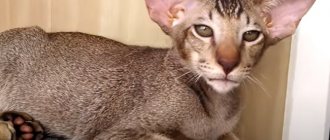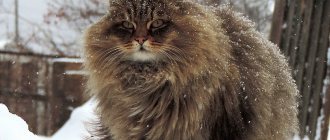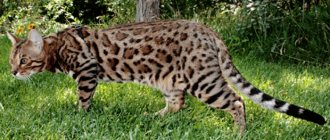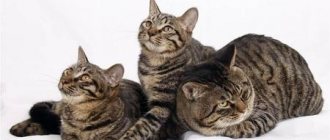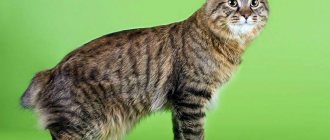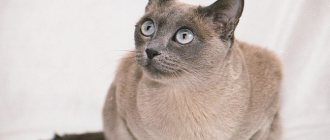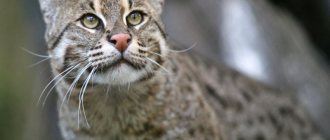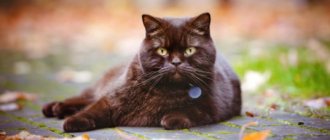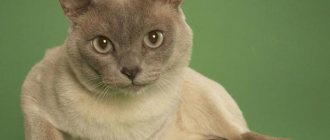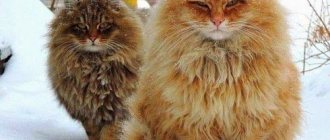- Wild animals
- >>
- Mammals
The stunningly beautiful and graceful ocelot looks truly royal. This amazing feline predator is very reminiscent of a leopard, which has been significantly reduced. It is not surprising that many people liked the ocelot, because its appearance captivates and bewitches, so people were able to tame this cat, making it a pet. Little is known about the mysterious ocelot living in the wild; let’s try to understand its character, habits and life activities in more detail.
Origin of the species and description
Photo: Ocelot
The ocelot is a not very large predator belonging to the cat family. Its name translated from Latin means “leopard cat.” The appearances of these animals are similar in many ways, the most significant difference between their appearance being their dimensions. There is another translation of the name “ocelot”; it comes from the language of the Aztec Indians and means “field tiger”, although this predator avoids settling in open spaces.
Not so long ago, scientists believed that felines appeared about 25 million years ago, however, at the dawn of the twenty-first century, another version was put forward regarding feline origin. Now experts claim that cats appeared precisely in Asian territory approximately eleven million years ago.
Video: Ocelot
The first to appear were large cats (of the panther genus), and then smaller ones, to which the ocelot is related. In general, among ocelots there are several subspecies that differ from each other, primarily in the place of their permanent location, but are almost identical in appearance.
To briefly describe the ocelot, we can call it something between a leopard and an ordinary cat. Compared to ordinary cats, it is quite large. A mature male reaches a length of more than a meter (130 cm), and a female reaches about 80 cm. The tail of ocelots is of considerable size - from 30 to 40 cm in length. The weight of males is about 15 kg, and females – 10.
This is a fairly powerful animal; for example, the shoulder width of an adult cat reaches half a meter. In terms of size, the ocelot can be compared to a large dog, such as a German shepherd. So, this cat is quite impressive in size.
Role in the ecosystem
Ocelots have a significant impact on their environment as predators. Although they feed primarily on terrestrial vertebrates, ocelots are opportunists and prey on many species of animals. They sometimes serve as prey for large predators (such as the jaguar (Panthera Onca)) and host numerous parasites.
Parasites:
- Paragonimus;
- Taeniidae;
- Strongylides;
- Toxocara feline;
- Capillaria;
- Spiruridae;
- Aelurostrongylus;
- Oncicola;
- Hammondia pardalis;
- Isospora.
Appearance and features
Photo: Ocelot animal
The ocelot's body is graceful, but strong and robust. The paws are solid and round, and the legs themselves are quite powerful and long. On the elongated neck there is a neat, slightly flattened head, on which widely spaced, rounded ears are clearly visible. The predator's eyes are very expressive, deep and slightly slanted. They are amber in color and stand out on the face with a bright black outline. The tip of the nose of these cats is pink.
The color of an ocelot's coat is a work of art. Perhaps, of all cats, he is the most beautiful and intricate. The main body tone is golden beige, the belly and the inside of the neck always have a lighter color. Bright spots (rosettes) throughout the body create a bizarre contrasting pattern.
The outline of the spots is very dark (almost black), and inside they have a lighter shade, which is darker than the main tone of the body, so it stands out beautifully against its background. Two bright dark stripes go up from the outlined eyes; the neck and cheeks of the ocelot are also beautifully lined. There are black specks everywhere on the paws. The tail of the predator is striped with a black tip.
Interesting fact: an ocelot's ears are black on top with a bright white spot in the middle, and white on the inside. From a distance, these spots on the ears can be mistaken for eyes, so scientists are divided on this feature. Some believe that it helps little kittens keep up with their mother by seeing her in front of them. Others argue that ocelots use these ear colors as a clever trick to fool other predators and mislead them.
The pattern located on the face and body may differ slightly in different subspecies of ocelot; in some cats, the entire background of the body has a grayish tint. Regardless of this, such a beautiful color of these amazing cats simply bewitches with its luxury and charm, captivating with its intricate magical and clear ornamentation.
Threats
Ocelots' beautiful fur is the reason why these cats have been one of the most heavily exploited small cat species. Between 1960 and 1970, more than 200,000 individuals were killed annually for the international fur trade. Commercial hunting has decreased significantly due to legal protection, however illegal trade still persists and the species is also in demand as a pet. Ocelots are sometimes killed in retaliation for attacks on poultry. However, the main threat to this species is considered to be habitat loss associated with deforestation for cattle ranching and agriculture.
Despite these threats, the ocelot remains the most common species of small cat in much of its range, reaching higher densities than smaller species such as the margay, and ocelots are even believed to negatively influence their small relatives. However, the low reproductive rate of ocelots, combined with the need for dense habitat and abundant small prey, may be contributing to population decline.
Where does the ocelot live?
Photo: Ocelot cat
The ocelot is a native inhabitant of America, both South and Central.
It can be found in the following areas:
- Brazil;
- Argentina;
- Bolivia;
- Ecuador;
- Mexico;
- USA;
- Peru;
- Venezuela;
- Paraguay;
- Colombia.
Zoologists note that the northernmost border of the ocelot’s range runs through the territory of the American state of Texas. Even in the recent past, ocelots also inhabited US states such as Arkansas, Louisiana, and Arizona, when the number of these cats was much greater. Nowadays, individual specimens cross the Mexican border and appear in Arizona, but these are isolated cases.
These graceful mustachioed predators have chosen an area near the Amazon River, covered with impassable, dense jungle, where cats feel at ease. The ocelot can live in tropical meadows, mangrove jungles and swampy areas. The animal prefers lush vegetation and chooses those places where it is abundant.
Ocelots have also been seen at high altitudes (about 4 km) in the Andes, although they usually do not climb higher than 1.5 km. It is almost impossible for a common man to see an ocelot in the wild, because he finds for his permanent place of residence such impassable thickets where a person cannot pass. In addition, he camouflages himself perfectly, and caution and secrecy are his second nature.
Range and habitats
A strong, incredibly beautiful and slender wild animal can be represented by several subspecies. All of them live in tropical forest zones in Central America, as well as in northern and central South America. The northernmost region where ocelots live is the American state of Texac. Also, a sufficient population size was noted in the southern part of Arizona in North America.
Return to content
What does an ocelot eat?
Photo: Ocelot cat
The ocelot is, first of all, a predator, so its menu is suitable for it, and because... Since it is not a very large predator, its prey is not distinguished by its weighty dimensions.
The cat menu consists of:
- Small monkeys;
- All kinds of rodents;
- Lizard and snake;
- Feathered;
- Insects;
- Crustaceans;
- Bakers;
- Fish.
When a cat is very hungry, he can attack both a small donkey and a domestic pig, but this is very rare. An ocelot can hunt for hours, carefully guarding its prey in ambush. When hunting large game, the ocelot hides in the crown of trees, looking down on the prey, and for smaller animals it usually conducts its observation from dense bushes. He has a lot of patience in this matter.
The ocelot attacks with lightning speed so that the prey does not have time to come to its senses; in one jump it knocks down the victim and strikes with a bite in the neck. Sensitive hearing, keen eyesight and an excellent sense of smell help the ocelot to hunt in the twilight.
Interesting fact: an unusual feature of this cat is the structure of its teeth, which are not designed for finely chewing food. Because of this, ocelots tear their prey into pieces with their fangs and absorb them whole, simply by swallowing them.
The minimum amount of food required by a mustachioed predator per day is 500 grams. The ocelot eats small prey from the head, and begins to eat large prey from the softest part, tearing out whole pieces, which it swallows whole. It is worth noting that ocelots living in captivity eat almost the same as in the wild. Only occasionally do specialized cat foods appear on the menu of domestic carnivores.
Character traits
Appearance
The ocelot is a small cat about the size of a lynx, but with dark spots. The body is compact and muscular. Both sexes are equally colored. The color of the coat depends on the environment in which the cats live. Forest-dwelling ocelots have yellowish or ocher fur, often tinged with cinnamon, while shrubby ocelots have greyish fur. Regardless of their habitat, their belly is white with black spots. And the fur itself is always silky smooth .
Photo: Caesar Kleberg
The ocelot's fur is decorated with irregular dark spots. Some of the dark spots have an elongated shape, more like stripes than spots. The patterns on the sides and back resemble rosettes, and the tail, paws and head are covered with dark stripes. The ocelot differs from the jaguar in being much smaller in size and having parallel black stripes on the back of the head and oblique stripes near the shoulder.
The tail is moderately long, edged with a black ring. The ears are dark, curiously pointed, covered with white spots. The eyes are brown ; when constricted, the pupils form spindle-shaped shapes. Since the ocelot is a predator, it has very strong paws with sharp claws.
Dimensions
Photo: Paul Donahue
The ocelot is the largest representative of South American cats. It is twice the size of a domestic cat, weighing up to 16 kg. Adult males can reach a body length of about 100 cm. The tail length sometimes reaches 45 cm. Females are usually smaller than males. They grow to a maximum of 93 cm and gain weight of about 10 kg.
- Body length: 68-100 cm
- Tail length: 26-45cm
- Shoulder height: up to 50 cm
- Body weight: 9-16 kg
- Average birth weight: 250 grams
Features of character and lifestyle
Photo: Ocelot animal
Ocelots prefer to live completely alone, forming pairs only for the mating period. They are sedentary animals with their own territories, the boundaries of which they carefully mark to avoid intrusion by strangers. The area of an adult male reaches 30 square kilometers; that of a female is half that size. Typically, the domain of one cat covers several plots of females.
Interesting fact: ocelots are excellent swimmers and climb not only trees, but also steep mountain slopes.
These miniature leopard-like creatures have excellent hearing, vision and sense of smell. Ocelots can communicate with each other using sounds. Sometimes they simply meow in their velvety cat melody, and during the wedding season they emit long, loud cries, looking for a lady of their heart. By nature, the ocelot is closed and secretive; it avoids people in every possible way, choosing impassable wild places for its life. These animals are very energetic and at the same time cautious; they try not to be an eyesore to other animals, hiding in dense growth.
Spotted predators go hunting at dusk, and in the light of the sun they cool down in shady thickets, on branches or deep tree hollows. The ocelot spends half the time of the day hunting, and he can travel considerable distances in search of prey, picking up the slightest sounds and vibrations of his potential victims, because the cat has a very highly sensitive hearing aid.
The ocelot's whiskers, like the strongest antennas, help it easily navigate any terrain and walk completely silently and gracefully, making its way through thickets and rock crevices. The lifespan of an ocelot living in the wild is about 14 years, and tamed individuals, with proper care, can live for a quarter of a century.
Those ocelots that live at home are quite smart, active and have a playful character. Their entertainment is somewhat reminiscent of dog games, they love to carry and retrieve a ball in their teeth, walking on a leash does not bother them at all, ocelots love to swim in a pool or any other body of water. But establishing strong friendships with other pets is very rare for an ocelot, because by its cat nature it is very independent and does not like competition.
Behavior
Ocelots are nocturnal. These strongly built cats are solitary and territorial. They are active 12-14 hours a day. Ocelots rest during the day on thorny piles of branches and vines, or among the roots of large trees. Although they tend to be more active at night, sometimes during the rainy season (especially on cloudy days) hunting occurs during the day.
They spend most of their time slowly patrolling their home range and often search for prey. Researchers have found that these cats check their territories every two to four days. Males typically travel twice as far as females due to their high energy requirements, as well as the need to test females for readiness to breed within their range.
Home range
Their home ranges range from 2 to 31 km², depending on their habitat. The ranges of males are larger than those of females and do not overlap with other males. However, as in many other mammal species, male territories tend to overlap with the ranges of several females. The population density of the species averages 4 individuals for every 5 km² in lowland tropical forests, and from 2 to 5 individuals for every 5 km² in more open areas.
Social structure and reproduction
Photo: Ocelot kitten
Female ocelots become sexually mature around one and a half years, and males at two and a half years. These predators do not have a specific time frame for the mating season, but usually weddings take place more actively from June to October. Often, it is the females who are the first to start looking for gentlemen, meowing loudly and inviting suitors, who respond to the call with loud cries. The female strikes the male with her strong paws to force him to begin mating. The duration of pregnancy is about 80 days.
The expectant mother is actively preparing a shelter for her offspring. It can be located in a spacious hollow, a secluded cave, or simply in dense bushes. The female makes a soft bedding from her own wool, which she tears out from her abdomen. An ocelot can have from 1 to 4 cubs, but most often there are one or two. Kittens are born already in a fur coat, which is a darker shade than their parents, but they are completely blind, the weight of newborns reaches 250 grams. A caring mother cat treats them with her milk for three months. After about 3 weeks, the kittens' eyes open.
Interesting fact: some male ocelots help the female raise her offspring. They bring food to her den and guard her home from other predators.
Babies grow quite slowly and only when closer to three months of age do they first leave their shelter. Then the mother or both parents begin to drag small animals to the den, teaching the children to hunt, and soon they take the grown-up children with them in search of food, instilling in them all the necessary skills. The kittens live with their mother for a long time and only when they are closer to two years of age do they begin to look for their own territory for permanent residence.
Ocelots as pets
It is quite possible to tame an ocelot and keep it at home if you take the kitten small, under the age of 3-4 months. If a kitten is not accustomed to people from a young age, it will grow up to be wild. This is one of the most expensive cats in the world. The price of a kitten averages 10 - 12,000 dollars, the price in Russia is about 1 million rubles. Ocelots are much more expensive than servals (450-500 thousand rubles) or lynxes (150-200 thousand).
Ocelots are active and energetic cats, so they require a lot of attention from their owners. Cats love to chew and bite various objects, such as their owners' fingers or clothes. May swallow small objects such as tennis balls if not supervised. Ocelots are affectionate and very cute animals, but they are too playful - they can destroy the entire house in a fit of energy, or accidentally bite their owners.
Salvador Dali had a pet ocelot named Babu. The artist took it with him everywhere, even on board an ocean liner. When in New York, visitors to a restaurant where Dali was dining were somehow frightened by an ocelot, the artist said that it was an ordinary domestic cat, which he had personally painted in the style of modern art.
Natural enemies of the ocelot
Photo: Wild ocelot
The ocelot is not a very large predator, so its enemies in the wild are larger cats. First of all, these are pumas and jaguars, they are very powerful, aggressive and strong, so the fight between them and the ocelot most often ends in the death of the latter. For young animals, caimans, boa constrictors and anacondas pose a threat. In addition, among ocelots such behavior as cannibalism is developed, when an inexperienced, weakened, young predator can become a victim of its larger and more powerful relative.
As sad as it is to realize this, the most important and most dangerous enemy of the ocelot is man. Until recently, the ocelot was actively pursued by hunters because of its beautiful and valuable fur. Only in the seventies of the last century, a huge number of ocelots were killed, and the predators were also sold live for fabulous sums. Hundreds of thousands of skins of this beautiful animal were illegally imported into the United States, a fur coat of which cost about forty thousand dollars at that time.
Another threat to ocelots is human intrusion into their permanent habitats and the destruction of those animals that the wild cat hunts. All this led to the fact that the ocelot was on the verge of complete extinction; now the situation has improved significantly. The main thing is that this favorable trend for the population of these cats continues.
Purchasing an Ocelot kitten, price
An ocelot is a very expensive acquisition, both in terms of the cost of the purchase itself (15-20 thousand dollars) and in terms of the conditions of full maintenance.
In addition, you should buy an Ocelot for home keeping only in specialized nurseries, which are found all over the world, including in Russia and Ukraine. If the animal does not have a complete set of necessary documents, the animal, according to the new laws, is subject to seizure by government agencies, and the owner will suffer administrative punishment.
Population and species status
Photo: Ocelot cat
For a long time, ocelots were subjected to mass extermination; trade in this graceful predator flourished. Both the skins of the animal and the living individuals themselves were valued, becoming popular among exotic lovers.
The seventies of the twentieth century were marked by the fact that the population of ocelots declined catastrophically; at that time they could have completely disappeared from the planet, so they were listed in the Red Book, taking strict protective measures for this amazing species of feline. Now hunting these animals is illegal, and trading ocelots is also prohibited, but illegal activities still occur today, although not on such a huge scale.
The number of ocelots has increased, now this animal is not under such an acute threat of destruction as before, but the population of the predator is still not very large. The number of these wild cats, although not so rapidly, gradually continues to decline.
Zoological scientists believe that the largest number of ocelots is concentrated in the Amazonian impenetrable jungle. In the 90s, they tried to count individuals, but the data on this varied, according to them, the number of ocelots at that time numbered from 800,000 to three million animals, that’s such a wide range in figures.
History of the evolution of the species
Throughout the 20th century, great damage to the population was caused by the popularity of coats made from the velvety fur of the ocelot. The fur of this beautiful cat was valued higher than the fur of the arctic fox, and poachers did not miss the opportunity to profit from the weaknesses of solvent fashionistas.
The word “ocelot” itself is of Indian origin and initially unites all small wild cats as such. The ocelot was called differently in different regions, but naturalists chose this name to designate the species, which began its formation approximately 2.4-1 million years ago. The closest species is margay cats.
In the 21st century, the wild ocelot can most often be found in Mexico and Argentina in the mountains, Amazon rainforests, mangrove swamps and all areas where human traffic tends to zero. In the United States, the ocelot is periodically recorded in Arizona and Texas.
Nutrition
Ocelots usually prey on small rodents and birds. Predators can sit on a tree for hours, patiently stalking their prey. And then they kill their prey with one quick and precise bite. It is interesting that the ocelot cat does not chew its food. With sharp teeth, he tears off the fibers of meat from a piece and simply swallows them.

